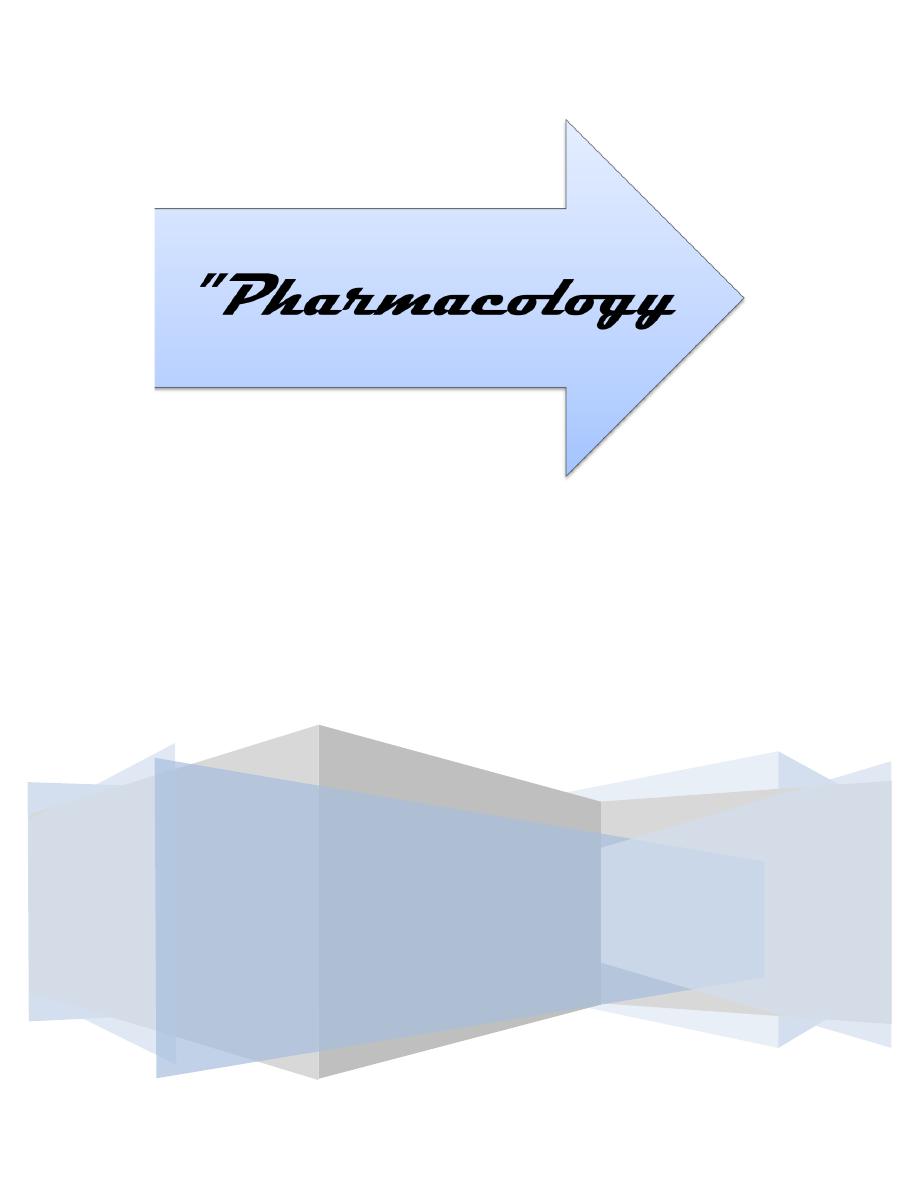
Sunday 16 / 11 / 2014
@Ali Kareem 2014-2015
Name
:
______________________________
Class
:
_______________________________
مكتب اشور لالستنساخ
DIURETICS
Lecture 2
Total lectures NO. 16
Dr. Naseer Al-Harchan

Low efficacy diuretics: (LED)
They are also called K conserving or K retaining, they lead to excretion of 5% of
filtered Na, and the site of action is distal convoluted tubule.
Some notes about Aldosterone:
It is a hormone secreted by the adrenal cortex in response to reduction in the
effective blood volume, hyponatremia, hyperkalaemia or in the presence of
angiotension. It acts to augment the renal tubular reabsorption of Na and Cl and to
augment the excretion of K (it acts to enhance Na and to excrete K), it also has a
little effect on H ion and probably this effect is consequence to its effect on Na ion.
Members of LED:
Spironolactone: this hormone is a competitive aldosterone antagonist and is also
called (true aldosterone antagonist), it is a homologous of natural aldosterone)
This hormone changes into active metabolite called (carrenone) and this
antagonizes aldosterone. It only acts in the presence of exogenous or endogenous
aldosterone. Its use leads to decrease K excretion
Uses:
1. The first use is to combine it with diuretics that lead to K excretion in which
hypokalemia is a problem.
2. Nephrotic syndrome.
3. Hepatic cirrhosis.
4. Refractory edema which doesn’t respond to other drugs.
*it is given al tablets orally
*it competes with aldosterone for receptors in the distal convoluted tubule

Side effects:
1. Abdominal pain.
2. Slight hyperuricemia.
3. In males gynecomastia.
4. Menstrual irregularity especially amenhorrhea in females.
Triamterene: it is not a true aldosterone antagonist, it doesn’t compete with
aldosterone for receptors in the distal convoluted tubule, it can act to retain K and
excrete Na, it only acts when diuretics are used with it that lead to Na excretion
(natriuretic effect) or it also acts in the presence of excess amount of aldosterone
either by pretreatment or spontaneous production.
* It is given as tablets orally.
Side effects:
1. Leg cramps.
2. In some patients it causes non-oliguric renal failure when endomethacine is
used with it.

Amiloride: it is related structurally to triamterene and it has uricasuric effect and
more potent than the rest, it is usually combined with thiazides in order to control
K level to some extent.
Osmotic diuretics:
They are weak diuretics as mannitol, urea, sugar site of action is proximal and
distal convoluted tubule and the collecting duct, they are non-electric substances
and this means that:
1. They are feely filterable from the glomerulus.
2. They undergo limited reabsorption in the renal tubule.
3. Pharmacologically they are inert substances.
They cause osmotic balance between the tubular fluid and peritubular fluid
(adjacent peritubular fluid) that limits backward movement of water and in this
way they lead to increase the volume of urine.
*Sugar in diabetic patients acts as osmotic diuretics.
*The sugar will pass with the tubular fluid and cross the kidney threshold so there
will be limitation in the movement of water = reabsorption.
Uses:
1. Prophylaxis of acute renal failure, they were largely used but because of
development of high efficacy diuretics H.E.D; their use is less now.
2. Eliminate some drugs that are reabsorbed in the renal tubules in acute
poisoning of salicylates, borbiturates, bromides or others
3. Reduce intracranial or intraocular pressure
4. Rarely used in resistant edema
*Mannitol is given in high concentration and the dose may reach 50-200 Mg in
24hrs infusion.

Carbonic anhydrase inhibitors:
Chemically they are sulfonamides considered as moderate acting diuretics; site
of action is distal convoluted tubule and slightly proximal convoluted tubule
C.A.
CO
2
+ H
2
O H
+
+ HCO
3
-
This reaction is catalyzed by the enzyme carbonic anhydrase, so by using the
inhibitors of this enzyme the result is less production of H ion and as we know
H ion is important for Na and HCO3 reabsorption and K excretion, so we have
increase in Na and HCO3 in urine with decreased NH4 in urine and we have
also K excretion.
Because less H is available for exchange with Na so we have increased volume
of urine, there might be metabolic acidosis because of HCO3 loss
Prolonged use=acidosis
*carbonic anhydrase is present in RBCs but such drug will not affect Co
2
transport in blood.
We have in this group: acetazolamide, ethoxazolamide and dichlorphenaride
Uses:
1. Glaucoma: when there is excess HCO3 in aqueous humor so they decrease
production of this fluid.
2. Epilepsy: not very clear mechanism.
3. Diuretic uses: much less used because of the availability of the other
efficient diuretics.
Side effects:
1. Renal calculi.
2. Hepatic coma in patients with hepatic failure.
3. Parasthesia.

Minor diuretics:
As xanthine, caffeine, theophylline and theobromine, they are weak diuretics,
site of action is distal convoluted tubule, and they are present in social drinks
as:
1. Tea = caffeine + theophylline
2. Coffee = caffeine
3. Cacao = theophylline + theobromine
*aminophylline is used in asthma is a combination of ethylenediamide and
theophylline.
Mode of action:
1. Improve cardiac output = GFR increase
2. Direct inhibition of Na reabsorption
*They are not used therapeutically, continuous use leads to lose their
effectiveness as diuretics
Mercurials:
They are not used nowadays because of high cardiac and nephrotoxic effects
Certain measurements used to know if the diuretics are working or not:
(assessment of their action)
1. Weight the patient before and after use
2. Input and output chart of the patient
3. Restrict salt intake
4. We must know if the patient takes other drugs. Ex: NSAIDS and others
